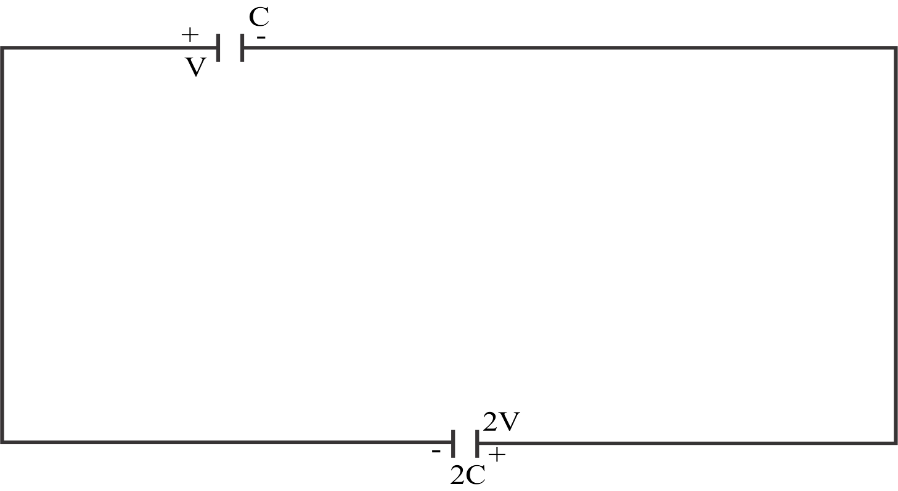Question
Question: A parallel plate capacitor of capacitance \(C\) is connected to a battery and is charged to a potent...
A parallel plate capacitor of capacitance C is connected to a battery and is charged to a potential difference V. Another capacitance 2C is connected to another battery and is charged to potential difference 2V. The charging battery is now disconnected and the capacitors are connected in parallel to each other in such a way that the positive terminal of one is connected to the negative terminal of the other. The final energy of the configuration is:
(A) Zero
(B) 625CV2
(C) 23CV2
(D) 29CV2
Solution
Hint It is given that two parallel plate capacitors are connected in parallel. Each capacitor has a different value of capacitance and charged to a different potential difference. To find the final energy configuration we should know the derivation of formula for energy stored in a capacitor.
Complete step by step answer
Capacitor is known as a charge storage device. The capacitance of a conductor is given by the ratio of the charge given to the conductor to the potential developed in the conductor.
When a charge q is given to a conductor, there will be a change in the potential. This change in the potential depends on the shape and size of the conductor.
⇒q∝V
⇒q = CV
⇒C = q/V
Where,
C is called capacitance of the conductor.
q is the charge given to the conductor
V is the potential developed in the conductor
We have to do work in order to store the charges in a capacitor. The work done will be stored as electrostatic potential energy in the capacitor.
The work done which is stored as the electrostatic potential energy is given by the formula
⇒U=21CV2
Where,
U is the electrostatic potential energy.
C is called capacitance of the conductor.
V is the potential developed in the conductor
If the capacitor is allowed to discharge, this energy can be recovered
Given,
The capacitance of the parallel plate capacitor one is C1=C
The potential difference in the capacitor C1 is V1=V
The capacitance of the parallel plate capacitor two is C2=2C
The potential difference in the capacitor C2 is V2=2V
It is given that the capacitors are connected in parallel to each other in such a way that the positive terminal of one is connected to the negative terminal of the other.
Let us draw a diagram using the above information

We have to find the final energy of the configuration.
We know that the energy stored in the capacitor is stored as the electrostatic potential energy which is given by the formula:
⇒U=21CV2
To find the final energy configuration we have to find the total potential difference and total capacitance of the above capacitor arrangement
The capacitors are connected in parallel to each other. When the capacitors are connected in parallel the total capacitance is given by the formula:
⇒CT = C1 + C2
⇒CT = C + 2C
⇒CT = 3C
The potential difference of the capacitor is derived from the formula
⇒VT=Cq
We don’t know the value of q but we know that V=Cq
The total capacitance is 3C
⇒V=3Cq
⇒q=3CV
Substitute the values
⇒VT=Cq
⇒VT=3C3CV
⇒VT=3C3CV
⇒VT=1V
The final energy configuration is
⇒U=21CTVT2
Substitute the values,
⇒U=213C×(1V)2
⇒U=23CV2
The final energy configuration is 23CV2
Hence the correct answer is option (C) 23CV2
Note To find the total potential difference across the capacitors circuit we should not directly add the potential difference across the capacitors. We should use the formula of capacitance to find the potential difference across the circuit.
